Final report for FW23-428
Project Information
This project addresses the loss of yields and marketability of vegetables due to the combination of insect pest damage and weather conditions. Insect-exclusion netting offers a tool for producers to reduce pest populations without chemical intervention. However, these row covers often create microclimates of increased temperature and humidity that can decrease the germination and overall yields of heat-sensitive crops.
The Community Supported Agriculture (CSA) model is economically beneficial for farmers by providing income in the beginning of the season when start-up costs are high and yields are generally low.This partnership requires the farmers to provide an abundance of high-quality, diverse vegetables for the duration of the CSA - often spanning 18 to 20 weeks, which is often challenged by pest pressure and extreme temperatures especially in spring and fall.
In order to make small-scale vegetable farming economically viable in the Southwest with the CSA model, research is needed to determine the effectiveness of different types and combinations of insect netting and shade cloth to successfully mitigate pest damage while also balancing out in field temperatures and moisture/water retention. This project incorporates row covers and insect-exclusion netting combinations to manage pest pressure and mitigate environmental stressors of high temperature and low moisture to determine how to generate the highest yields and quality of eleven vegetable crops.
A field day was held on the farm to demonstrate best practices and findings with other farmers in the area, using the Roaring Fork Farmers and Ranchers group and the regional chapter of the Rocky Mountain Farmers’ Union to inform and educate other local producers. One presentation at a regional agricultural conference in January 2024 shared results with a broader audience.
Research Objectives
Objective 1: Compare and document yield and quality of crops grown with insect-exclusion netting and/or shade cloth materials to crops grown without insect-exclusion netting and/or shade cloth.
Objective 2: Help farmers increase the marketability and profitability of produce (specific crops) by reducing average yield loss from insects, and high temperature and aridity.
Objective 3: Share our findings and practices with other vegetable producers in the Colorado River and Roaring Fork Valleys of Colorado who face similar challenges of excluding pests with row covers while also creating optimal temperature and moisture for crops in increasingly extreme growing conditions.
Objective 4: Master growing techniques using described resources and found knowledge to provide enough diversity to support a 100 member (CSA) program with chemical-free produce from June to October.
Education Objectives
Objective 1: Build awareness with local community members around the challenges of growing vegetables in the arid Southwest.
Objective 2: Host an on-farm field day for farmers to share results and knowledge gained from research project and demonstrate to other local producers best practices for incorporating shade-cloth and insect-exclusion netting.
Objective 3: Synthesize data from the study, and present knowledge gained and challenges to other local producers.
Objective 4: Create a one page project summary with a description of the crops studied and best practices (insect-exclusion netting and shade cloth combinations) that can be shared among producers and passed on to Highwater Farm staff for the 2024 and 2025 growing seasons.
|
Date |
Activities |
Team Members |
|
Early May 2023 |
Seeded flats of winter squash in greenhouse |
PI (Becca) + team member (Sara) |
|
Early May 2023 |
Seeded flats of red cabbage, green cabbage, napa cabbage and broccoli |
PI (Becca) + team member (Sara) |
|
Late May 2023 |
Prepared Field 2 ( 8 beds in west field) for winter squash transplant; composted, harrowed, flame weeded |
PI (Becca) + team member (Sara) |
|
Late May 2023 |
Prepared Field 1 ( 8 beds in North field) for cabbage and broccoli transplant; composted, harrowed, and flame weeded |
PI (Becca) + team member (Sara) |
|
June 2023 |
Transplanted winter squash; covered 4 beds with insect exclusion netting immediately after transplanting + left 4 beds uncovered as control |
PI (Becca) + team member (Sara) |
|
June 2023 |
Transplanted cabbages and broccoli; covered 4 beds with insect exclusion netting immediately after transplanting + left 4 beds uncovered as control |
PI (Becca) + team member (Sara) |
|
July 2023 |
Removed insect-exclusion netting from squash (when it began to flower) - collected field notes on quality and health of plants |
PI (Becca) + team member (Sara) |
|
July 2023 |
Harvested cabbages and recorded yields. |
PI (Becca) + team member (Sara) |
|
July 2023 |
Built caterpillar tunnel for shade cloth in Field 3 for fall brassica/greens planting |
PI (Becca) + team member (Sara) |
|
Early August 2023 |
Prepared Field 3 (8 beds in western part of North field) for fall brassica/greens planting (mustards greens, spinach, asian greens, arugula); composted, harrowed, flame weeded |
PI (Becca) + team member (Sara) |
|
Mid August 2023 |
Seeded fall brassicas and greens, and covered with insect-exclusion netting and shade cloth |
PI (Becca) + team member (Sara) |
|
September 2023 |
Harvested winter squash; recorded yields |
PI (Becca) + team member (Sara) |
|
Mid September 2023 |
Harvested greens; recorded yields |
PI (Becca) + team member (Sara) |
|
September 2023 |
Invited local vegetable producers to the farm for a field day demonstration; answered questions + facilitated discussion on best practices and lessons learned |
PI (Becca) + team member (Sara) |
|
September 2023 |
Harvested greens and recorded yields |
PI (Becca) + team member (Sara) |
|
September-October 2023 |
Continued to harvest greens; recorded yields |
PI (Becca) + team member (Sara) |
|
January 2024 |
Compiled data/photos from research; presented best practices at the annual Food and Farm Forum in Montrose, CO. |
PI (Becca) and team member (Sara) |
Cooperators
- - Producer (Educator)
- - Technical Advisor (Researcher)
Research
Research Objectives:
Objective 1: Compare and document yield and quality of crops grown with insect-exclusion netting and/or shade cloth materials to crops grown without insect-exclusion netting and/or shade cloth.
Objective 2: Help farmers increase the marketability and profitability of diverse vegetables by reducing average yield loss from insects, and high temperature and aridity.
Objective 3: Share our findings and practices with other vegetable producers in the Colorado River and Roaring Fork Valleys of Colorado who face similar challenges of excluding pests with row covers while also creating optimal temperature and moisture for crops in increasingly extreme growing conditions.
Objective 4: Master growing techniques using described resources and found knowledge to provide enough diversity to support a 100 member CSA program with chemical-free produce from June to October.
Project Site: This project took place at Highwater Farm in Silt, Colorado. 2023 was the fourth full season in production. Pest populations in 2022 caused significant loss to yields and quality of vegetable crops. This project was designed to measure yields, soil moisture and temperature of 11 different vegetable crops including red cabbage, green cabbage, napa cabbage, broccoli, butternut squash, delicata squash, pumpkins, spinach, arugula, mustard greens, and asian greens, all of which contribute to the diversity of the CSA program and impact the economic viability of the farm.
Research Design: For each crop, two beds were prepared with the same techniques. One bed (150’) was transplanted / direct seeded and immediately covered with insect-exclusion netting (Proteknet) and a combination of shade cloth* (see crop plan below for more detail). The second bed of the same crop (150’) was transplanted or direct seeded and left uncovered. Irrigation practices were the same for each crop. Soil temperature and moisture data was collected via sensors in the soil that connected and aggregated data to a climate and weather app system already used to collect data on the farm. At harvest time, yields were measured based on practices already in place at the farm for data collection. The harvest date and weight of produce coming from the field was measured after the produce was washed and was added to the spreadsheet tracking this data. When the entire bed was harvested out, yields from the experimental plot were compared to the control plot for each crop and logged in the SARE data collection sheet managed by the farmers.
All bed preparation for research blocks was uniform and completed within the same window. The farm uses a standard practice for bed preparation which begins by applying compost to the raised beds and running a power harrow implement attached to the tractor to incorporate compost and level the soil for a uniform seedbed. This allows the farmers to prepare all beds in a planting block efficiently and uniformly. All beds were flame-weeded immediately before planting. After transplanting, irrigation was be set-up either with overhead wobblers or drip-line.
Tools/Materials
This project required insect-exclusion coverings (Proteknet - a knitted, UV resistant row cover made of polyamide mesh ) and shade cloth. Crops in Blocks A, C and E were covered immediately after transplanting or direct-seeding with small hoops and insect-exclusion coverings. Crops in blocks B, D and F remained uncovered as a control plots. Additionally, the research beds in Field 3 were covered with shade cloth, as these heat sensitive crops have low germination rates or experience bolting when exposed to high temperatures. 50% shade-cloth is optimal for these crops, which for the study include mustard greens, asian greens, spinach, and arugula. To maximize the farmers time and efficiency, a caterpillar tunnel frame (100' x 16') provided the infrastructure to support shade cloth covering 4 beds. The tall hoops of the caterpillar tunnel made the management and harvest of the crops easier and more efficient, while providing the flexibility to build and deconstruct the structure in just a few hours.
Conventional alternatives exist but are not designed for small-scale production or do not align with the farm's values. These alternatives include: spraying chemical pesticides to control pests, which is cost and time prohibitive for farmers and destroys beneficial pest populations; large shade structures that are permanent and difficult, if not impossible to move, without machinery or specialized tools; and shade cloths that filter UV but offer little to no protection from small-body pests that inflict damage to crops, such as flea beetles and squash bugs; or insect-exclusion netting that prevents ventilation and air-flow, and raises localized soil temperatures that are not optimal for sensitive crops.
At a local level, these tools are needed immediately. Farmers in the area put in a tremendous amount of time protecting the quality of vegetable crops from extreme environmental conditions. With increasingly mild winters, pest populations do not die back with hard freezes. For farmers in other regions, many of the environmental challenges faced currently by growers in the southwest will become normalized occurrences, thus making this project and its results more important than ever.
Methods of Analysis
Harvest weight of crops in the research block were collected in the wash station - a system the farm already utilized to measure yields. The harvest weights of each crop and corresponding beds were captured in an excel spreadsheet (see Crop Plan Yields and Results).
Soil moisture, temperature, and wind speed were collected from sensors in the field that connected to the farm's integrated weather system, which is used to collect and aggregate data over time.
Overall, there were yield differences between control and study rows in each crop and variety. 7 of the 11 crops/varieties analyzed had a positive yield response to netting and/or shade cloth co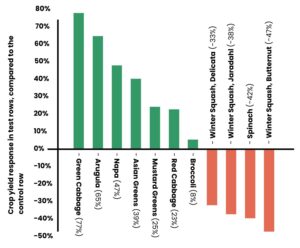 ver compared to the control. Crops with positive yield response include red cabbage, green cabbage, Napa cabbage, arugula, asian greens, mustard greens, and broccoli. Crops with negative yield response to netting and/or shade covering compared to the control. These included Delicata winter squash, Jaradahl winter squash, buttternut squash, and spinach. The table and graph below illustrate how the yield differences vary by crop.
ver compared to the control. Crops with positive yield response include red cabbage, green cabbage, Napa cabbage, arugula, asian greens, mustard greens, and broccoli. Crops with negative yield response to netting and/or shade covering compared to the control. These included Delicata winter squash, Jaradahl winter squash, buttternut squash, and spinach. The table and graph below illustrate how the yield differences vary by crop.
There was a positive and significant yield response from brassicas crops including red cabbage, green cabbage, napa cabbage and broccoli with insect netting. It is recommended that these crops are covered with insect-exclusion netting after transplant. Observations in produce quality indicated less pest damage and better quality produce on average from crops with some combination of shade and/or insect-exclusion netting, thus increasing the quality and marketability of crops for CSA.
In addition to increased yields, the covered cabbages produced yields earlier, with larger heads and less insect damage. Test cabbages matured 2.5 weeks early, likely due to decreased pest pressure/stress under insect netting. Limited pest pressure on covered crops resulted in more efficient cleaning and processing. Farm staff spent a significant amount of time in the harvest and wash process cleaning the uncovered cabbages of cabbage worms before distributing. The quality of cabbages in the test plot was higher than the control plot, thus increasing its marketability for CSA. Cabbage worms/moths were first detected in the block on 6/29. Staff spent additional harvest and pack hours manually removing cabbage worms from the heads of cabbage that were uncovered.
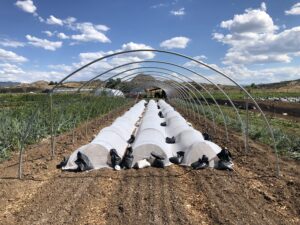
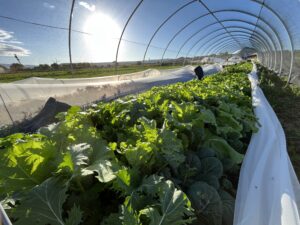
Fall seeded brassicas and greens, including mustard greens, asian greens and arugula also had positive yield results with an insect exclusion netting and shade cloth combination. To increase efficiency, caterpillar tunnel hoops were used to cover three beds in the test plot with shade cloth. The infrastructure was built in one day and saved significant time during the cultivation, maintenance, and harvest of this block. Based on these results, covering is recommended for these crops. The quality of greens in the test plot (covered with insect-exclusion netting/shade cloth) was much higher and showed very little damage from common pests like aphids and flea beetles. Additionally, the greens were more tender upon harvest than greens that were in the control plot and exposed to more wind and UV. Greens in the control plot tasted more bitter.
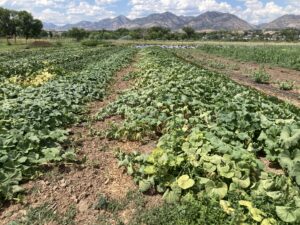
Winter squash varieties had a negative yield impact from insect exclusion netting test rows. A light, late frost in June caused damage to the winter squash leaves where it touched the insect-exclusion netting, which weakened the plants in the covered plot. Additionally, the micro-climate under the insect-exclusion netting likely created more ideal conditions for the pathogen bacterial fruit blotch (BFB) to proliferate due to increased humidity and decreased air flow. Approximately 30% of the winter squash plants in the covered block were pulled before producing fruit as a means of containing the soil pathogen and thus impacting yield and production data. Lab tests from Colorado State University confirmed the presence of BFB in the samples sent. Interestingly, BFB was not detected in high quantities in the uncovered plot, likely due to the increase of air-flow without protective covering. The quality of winter squash in the test plot compared to the control plot was negligible. Squash bugs were first detected in the block on 6/12 and as a result, staff scouted the block twice per week for 30 minutes collecting squash beetles and eggs by hand.
Spinach also had a negative yield impact in the shade cloth and insect netting row compared to the control; however, this is likely due to low germination rates based on irrigation practices. Germination rate was about 60% for the test plot and for the control plot. Based on these results, covering spinach crops with shade cloth/insect-exclusion netting is not recommended.
The cost of materials including insect-exclusion netting, sandbags and hoops for the covered beds was approximately +$100/100ft. Additional labor required to cover/uncover beds was approximately +3.3hr./100ft. With careful care, we estimate the insect-exclusion netting will last for 5 years. An important consideration for small-scale farmers is whether or not the cost of investing in materials like insect-exclusion netting and shade cloth are worth the increase in yields and marketability. For Highwater Farm, insect-exclusion netting/shade cloth will be used on spring brassicas and fall planted greens based on the significant increase in yields recorded. Other producers can use this data and the calculator tool developed by the Technical Assistant as a reference to help determine whether or not the cost benefit is worth the investment in time and materials based on their own scale of production. 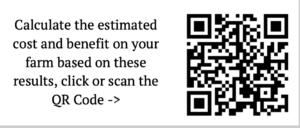
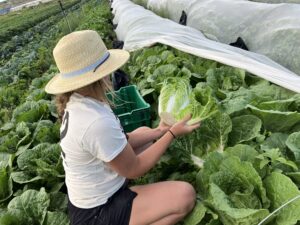
Insect Data
While insect cards were placed throughout the season, unfortunately resulting data weren’t able to be analyzed. Field notes and observational information was collected to assess quality and yield impacts.
Important dates observed related to insect-pest emergence include: squash bugs first detected 6/12 and cabbage moths first detected 6/29.
Soil moisture and temperatures
Electronic in-ground soil moisture probes are not recommended. It was challenging to keep the battery charged with intense UV and temperature swings. The probes were also watered by overhead irrigation sprinklers and would get disconnected from the weather station. Research specifically on the most effective soil moisture probes for small-scale farmers would be helpful. For this type of monitoring, a probe that can be read instantaneously, carried to different parts of the field, and then stored indoors, would be recommended.
The following charts show the temperature range, precipitation, and wind speed during the data collection period.



Research Outcomes
The outcomes of this research project provided tangible recommendations on what types and combinations of insect netting and/or shade cloth result in the highest yields for 11 specific vegetable crops. Yields and quality of spring planted red cabbage, green cabbage, napa cabbage and broccoli were significantly higher in the plot covered with insect-exclusion netting due to a decrease in cabbage worm pressure. Covering is recommended for spring planted brassicas.
Yields of winter squash covered with insect-exclusion were significantly lower than squash left uncovered. Covering with netting is not recommended, despite intense pest pressure from squash bugs.
Lastly, fall planted brassicas including mustard greens, asian greens and arugula produced higher yields and higher quality product when covered with insect exclusion netting and shade cloth. Three beds were covered with shade cloth under a caterpillar tunnel structure, which made it faster and more efficient to cultivate and harvest. Covering with both shade cloth (to lower soil temperature for better germination and decrease bolting) and insect netting to exclude flea beetles and aphids is recommended.
Insect netting, shade cloth and associated infrastructure can be expensive to purchase and time consuming for small-scale producers to construct and maintain. The outcomes of this research as noted above have specific recommendations on which crops are worth the investment in insect netting and/or shade cloth based on yields, and which crops had adverse or negligible yields and are not recommended to be covered. This information can help other small-scale producers invest in the appropriate materials needed to produce diversified vegetable crops in challenging climate conditions.
Further Research
One recommendation for further research would be to study additional crops outside of the 11 crops selected for this project. Examples could include tomatoes, peppers, eggplant, lettuces, radish/turnips, and/or summer squash, and could similarly test different types of plastic, shade cloth and/or insect netting types and materials.
Education and Outreach
Participation Summary:
Education Objectives:
Objective 1: Build awareness with local community members around the challenges of growing vegetables in the arid Southwest.
Newsletters with farm updates are sent out weekly to 120+ CSA members, and one week included a detailed description on the SARE experiment and results. This resulted in a number of CSA members asking questions and engaging with the research at weekly on farm distributions. Direct education with members helps strengthen the CSA model by educating non-farming members about the challenges of growing food in an arid climate. The concept of CSA, where farm members are invested in the risks and rewards of the model, is strengthened when CSA members better understand how the vegetables they access each week are grown.
The Farm Manager also designed and led two educational workshops on site. The first workshop was 1.5 hours and was designed to share SARE project design and results with three beginning farmers (less than 2 years of experience). The second workshop was 1 hour and was designed for 12 youth (ages 14-17) involved in Highwater's summer job training program for local teenagers.
Objective 2: Host an on-farm field day for farmers to share results and knowledge gained from research project and demonstrate to other local producers best practices for incorporating shade-cloth and insect-exclusion netting.
21 participants came to the farm in October for an on-site field hosted by Highwater Farm staff and CSU Extension. Field day participants included local growers, CSA members, board members and other food system advocates. A farm tour (30 minutes) and a description of the SARE research and findings was followed by a Q&A session where participants asked questions about project design, implementation, results and recommendations. A one-pager handouts with research and yield results were distributed to each participant at the field day.
Objective 3: Synthesize data from the study, and present knowledge gained and challenges to other local producers.
Yield data was collected as research plots were harvested and in the fall of 2023, data was synthesized by the PI, Team Members and TA. Information on research design, including materials used, and research results/ recommendations were distilled into a one-page document that was distributed at workshops, the field day, and at the Soil Health / Food and Farm Forum presentation. Additionally, the one-pager has a QR code linking to a calculator developed by the project TA (Drew Walters - Agriculture Specialist - CSU Extension Pitkin County). Producers can use the calculator to help determine whether the investment in materials will have a significant impact on their farms to warrant the purchase of materials. The calculator utilizes the yield and cost data collected from this experiment to help determine recommendations.
Additionally, the PI and team member presented findings at a Soil Health conference to 65+ farmers/producers in Montrose, Colorado on January 26th, 2024. The presentation was recorded and is available at request from Highwater Farm.
On-site field days are recommended, as they provide an engaging way for local producers to see the experiment design in action. It can also offer practical examples of how farmers can set-up similar infrastructure at their own operations. Highwater Farm’s field day was strategically held on Friday, October 6th, an evening in the fall, so local farmers/growers had the bandwidth and time to leave their own operations and participate in a farm tour. Staff explained and answered questions about research results and project implementation.
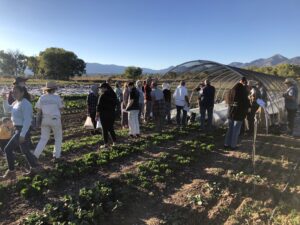
A flyer was generated to help promote the Field Day on social media platforms, email lists, and directly with other producers.
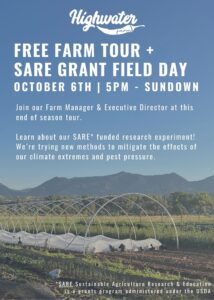
One benefit of presenting at an agriculture conference is that it can capture a larger audience. Highwater presented at the annual Soil Health / Food and Farm Forum in Montrose, Colorado in January, which captured 200+ guests including farmers, ranchers and food system advocates. The presentation included a 45 minute slideshow with an overview of the farm and growing practices, and the SARE experiment results and design with 15 minutes for Q&A. Questions at the Food and Farm forum tended to be more general than questions at the on-site field day. At a conference, the material presented is often more broad. The presenters also had to spend time explaining the context and background of the operation. The presentation at the conference was the first step in other producers implementing similar practices, but still left questions as how to actually acquire materials, build structures, etc. At the field day, questions asked focused mainly on the specific materials used and direct implementation of practices. The context of producers visiting the farm and seeing the research in action resulted in more specific questions and a more likely chance that producers will adopt new practices.
Education and Outreach Outcomes
Row Cover/ Insect-Exclusion netting materials
Diversified Vegetable Crop Production
Pest Management with biological and cultural controls
Season extension infrastructure construction and implementation
Shade Cloth for UV protection
Growing vegetables in an arid climate